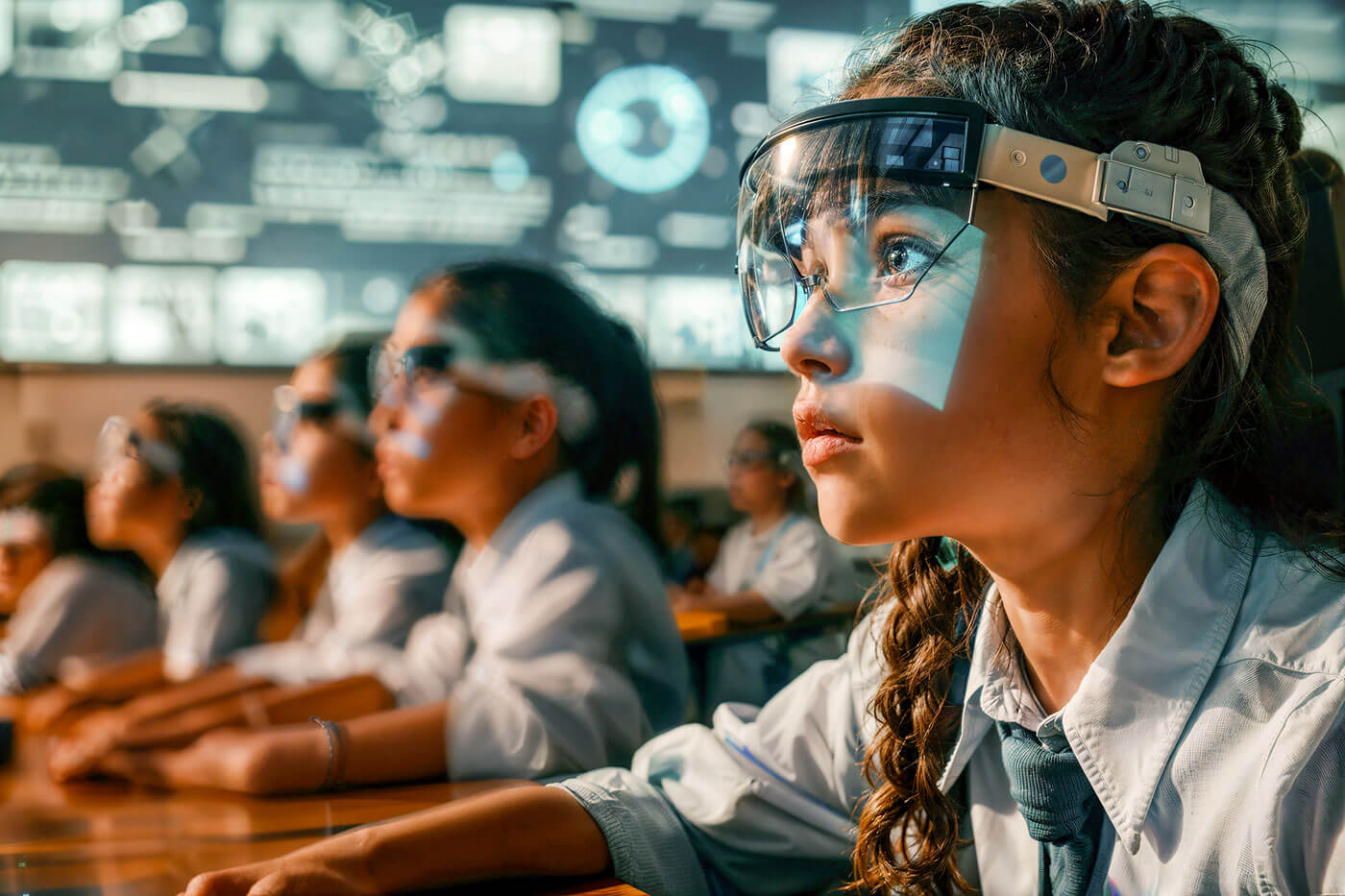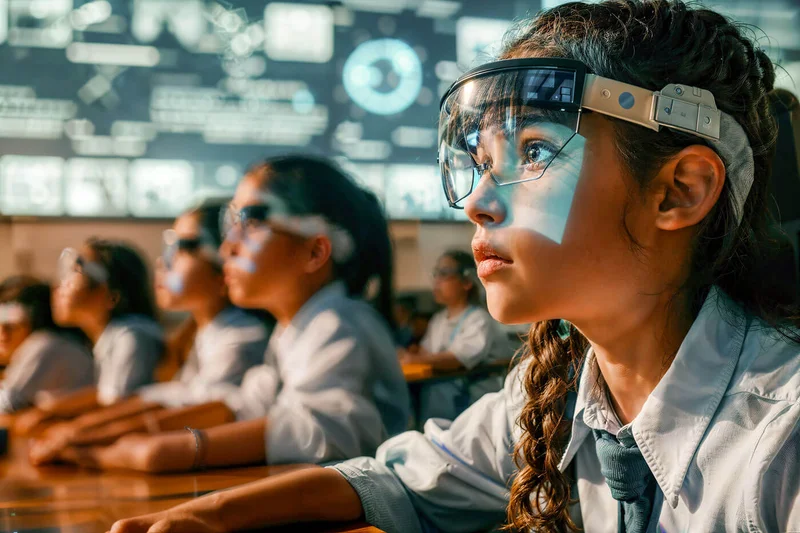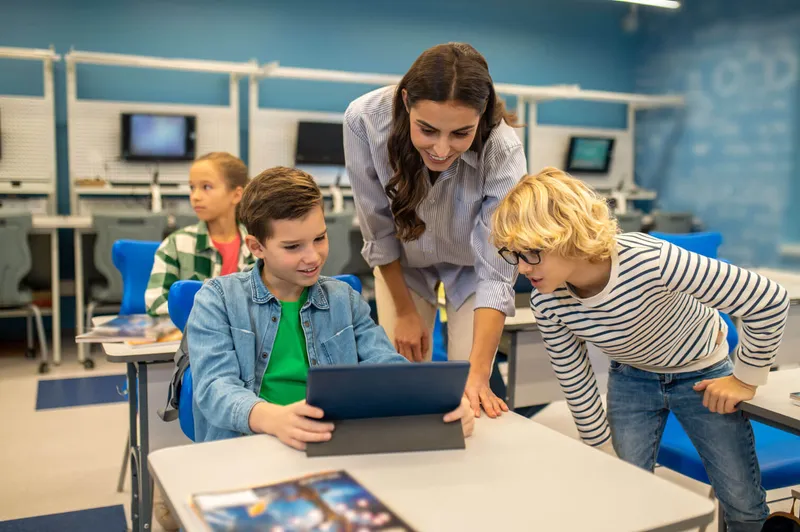
Part 4: Designing for AI-Enabled Learning – Responding to the Changing Landscape of Education in Gold Coast Schools
This is the final part of our four-part series on designing effective educational environments. Read Part 1 on Acoustics, Part 2 on Colour Psychology, Part 3 on Collaborative Spaces, or view the series introduction to learn more about our approach to educational architecture across the Gold Coast.
Why AI Is Changing the Conversation
Artificial intelligence is rapidly shifting the way students engage with content, teachers deliver lessons, and schools structure their curriculum across Queensland. Once a distant concept, AI tools are now appearing in everyday classroom practice on the Gold Coast — from adaptive learning platforms to real-time feedback systems and generative research tools.
A 2023 survey conducted by the Education Data Initiative found that over 60% of educators in Australia and New Zealand had trialled or adopted AI-supported tools in some form.¹ The same study indicated that while adoption is still uneven, school leaders throughout Queensland are increasingly preparing for AI to play a formalised role in their digital infrastructure.
This shift raises a timely question for Gold Coast architects and school planners: what does the increasing integration of AI mean for learning space design? How can we create environments that support both technological innovation and meaningful human interaction?

What the Research Tells Us
The physical classroom must increasingly support multiple learning modes — individualised instruction, small-group collaboration, and digital interaction — often all within the same session. AI integration only amplifies this complexity in Gold Coast Queensland schools.
A 2023 white paper from the OECD highlights the spatial implications of AI in education, noting that traditional classrooms may no longer suit the diversity of activities supported by intelligent tools.² As technology becomes more embedded, flexible and tech-ready environments will be essential across Queensland’s educational facilities.
Research-Based Design for AI-Enabled Learning
A recent Learning Environments Research article emphasized the importance of “agile infrastructure” — not just digital connectivity, but physical adaptability — to support emerging educational technologies, including AI-driven personalized learning.³
This research suggests that Gold Coast schools must consider both immediate practical needs and longer-term flexibility as they develop spaces that can evolve alongside rapidly advancing technologies.
Design Implications: What Needs to Change?
While Gold Coast schools are still in the early stages of AI adoption, the trajectory suggests that future-ready learning environments will need to be both technologically and spatially adaptive. In many cases, this may not mean starting from scratch — but rather refining and extending existing flexible learning models to accommodate AI’s unique demands across Queensland’s education sector.
1. From Flexible Layouts to Parallel Learning Pathways
Supporting Diverse Learning Modes
Many Australian schools have already moved away from traditional, uniform classroom layouts. Flexible spaces that support movement, collaboration, and varied teaching modes are now common — particularly in Gold Coast schools that have embraced 1:1 device programs and collaborative learning models.
AI builds on this foundation, rather than replacing it. While teachers have long differentiated content and pace to meet individual student needs, AI tools introduce the potential for this personalisation to happen in real time, guided by student interaction, progress, and data. This added responsiveness may amplify the diversity of activity occurring within a single space — with students working on different tasks, using different tools, and progressing at different speeds simultaneously.
This evolution invites spatial responses in Gold Coast Queensland schools such as:
- Zones that allow students to self-select focus, collaboration, or tech-supported modes
- Configurations that accommodate a mix of independent and group work in parallel
- Integrated access to digital displays, projection surfaces, and writable zones
- Greater spatial fluidity that allows for more than one learning narrative to unfold at once
These layouts aren’t new in concept — but AI makes their flexibility more critical, and their configuration more nuanced for Queensland’s learning environments.
AI-Ready Learning Environments for Gold Coast Schools

The most successful AI-ready environments in Gold Coast schools balance technological infrastructure with human-centered design. They provide the connectivity and adaptability needed for advanced digital tools while maintaining the spatial qualities that support wellbeing, connection, and varied learning modes.
These spaces recognize that technology should enhance rather than dictate the learning experience, with architecture that remains flexible enough to accommodate both current needs and emerging possibilities in Queensland’s evolving educational landscape.
2. Building on Existing Infrastructure for Seamless Tech Integration
Most Gold Coast schools already provide robust access to devices, Wi-Fi, and cloud-based platforms. However, AI-assisted learning increases the demand on infrastructure — especially where platforms use real-time feedback, generative content, or dynamic assessments.
Tip
Design responses across Queensland educational facilities may need to go beyond general tech readiness and include:
- High-capacity connectivity to support multiple AI-enabled platforms operating simultaneously
- Evenly distributed charging solutions, avoiding reliance on wall-access-only power
- Integrated voice-activated or mixed-reality interfaces, which may change how students interact with their environment
- Flexible AV systems that allow AI-based content to be displayed, annotated, or discussed in groups
- Cyber-safe zoning or secure digital access points, particularly for platforms using cloud analytics or learning data
In short, the infrastructure that supports AI needs to be ubiquitous, secure, and future-adaptable — not simply available in Gold Coast Queensland schools.
3. Acoustics and Visual Privacy for Hybrid Learning

As AI tools begin to include real-time speech recognition, verbal commands, and virtual tutoring sessions, acoustics become even more important in Gold Coast Queensland schools. The presence of multiple audio inputs and outputs in the same room requires careful spatial planning to avoid distraction and fatigue.
At the same time, design strategies that support acoustic separation must also maintain visual connectivity — allowing teachers to observe and guide students effectively. Overscreening or full enclosures can create supervision challenges, especially in primary or mixed-ability settings across Queensland’s education system.
Balancing Acoustics and Visibility
Considerations for Gold Coast schools may include:
- Soft furnishings and acoustic panels to absorb overlapping sounds
- Designated semi-open audio zones for students engaging with voice-activated platforms
- Glazed or low-height partitions that reduce visual distraction while still enabling passive supervision
- Layouts that offer clear sightlines across the learning area, even in flexible or multi-modal spaces
AI-supported learning doesn’t always involve speaking — but when it does, the environment must support clarity, comfort, and continued visibility for effective classroom management in Queensland’s diverse educational settings.
4. Designing for Movement and Data-Aware Use Patterns
AI-enabled classrooms often collect and respond to behavioral data — from on-task movement to eye contact, participation, or gesture. While ethical guidelines are still evolving in this area, spatial design in Gold Coast Queensland schools may begin to reflect these shifts.
Spaces may increasingly:
- Encourage fluid transitions between digital and physical activity
- Provide room for kinaesthetic learning alongside digital engagement
- Support real-time teacher oversight without disrupting students’ personal workflows
- Be arranged to respect data privacy while still allowing engagement tracking tools to function
The goal is to ensure that design never compromises trust, but supports the safe, meaningful integration of AI into everyday teaching across Gold Coast educational environments.
5. Planning for Staff and Professional Development Needs
Supporting Teacher Adaptation
As AI tools become more common, school staff across the Gold Coast need the time and space to plan, upskill, and collaborate. Staff areas may need to evolve in parallel with student spaces, offering:
- Quiet zones for lesson planning using AI-based platforms
- Shared workspaces for collaborative curriculum development
- Resource hubs with digital training tools or remote access to ed-tech advisors
Designing future-ready schools means ensuring that Queensland educators are supported — not just technologically, but spatially.
Our Approach at Burleigh Beach Designs
The conversation around AI in education often centres on the technology itself, but the physical environment plays an equally important role in successful implementation. Drawing from twenty years of experience in the education sector, I’ve observed how thoughtfully designed spaces can either enhance or hinder the integration of new technologies. As we look to partner with Gold Coast schools, our focus is on creating environments that will empower teachers to harness these tools while maintaining the human connections that are at the heart of effective education.
At Burleigh Beach Designs, we are closely following developments in educational technology and the role that AI is beginning to play in reshaping school environments across the Gold Coast and Queensland. Our design approach is grounded in research, with a focus on flexibility, functionality, and user wellbeing — ensuring that the spaces we plan can evolve alongside the technologies that support them.
In designing AI-ready learning environments for schools, our approach prioritises:
- The school’s specific teaching philosophy and how AI tools might enhance rather than disrupt it
- The balance between technological infrastructure and human-centered spaces
- Long-term adaptability that allows for integration of emerging technologies
- The relationship between digital tools and physical space in supporting diverse learning needs
By combining architectural expertise with educational insight, we create Gold Coast Queensland learning environments that embrace technological innovation while preserving the qualities that make physical schools invaluable: human connection, collaboration, and community.
Looking Ahead
The integration of AI in education is still evolving across the Gold Coast — and so are the design responses. What’s clear is that flexibility, connectivity, and adaptability will underpin the next generation of learning environments in Queensland schools.
For design teams, this means asking different questions:
- How do students move through digital and physical space?
- How do we design for tools that are still emerging?
- How do we support both technological innovation and human connection?
Note
About the Author: Simone McDonald brings over 20 years of valuable education sector experience to Burleigh Beach Designs. Before joining our team, she worked extensively within the education system, developing a deep understanding of how physical environments impact learning outcomes. Her unique perspective helps bridge the gap between architectural theory and practical educational needs, particularly in designing spaces that effectively support the integration of emerging technologies in learning environments.
Series Conclusion
This concludes our four-part series on designing effective educational environments. Throughout these articles, we’ve explored how thoughtful architectural design can enhance learning outcomes through careful consideration of acoustics, color psychology, collaborative spaces, and technology integration.
As Gold Coast architects specialising in educational design, we understand that schools are complex ecosystems where every design decision impacts teaching and learning. By combining research-based principles with practical experience and local context, we create spaces that truly support the needs of Queensland’s students, educators, and communities.
We hope this series has provided valuable insights into the many factors that influence successful educational environments. If you’d like to discuss how these ideas might apply to your next project on the Gold Coast, we welcome the conversation.
Explore Our Complete Educational Design Series
This article is the final part of our four-part series on designing effective educational environments. Explore the complete series to gain a comprehensive understanding of key considerations in educational architecture:
- Part 1: Acoustics – Designing for Clarity, Concentration and Connection
- Part 2: Colour Psychology – Designing Visual Environments That Support Learning, Mood and Focus
- Part 3: Designing for Collaboration – Supporting Flexible Learning Through Space
- Part 4: Designing for AI-Enabled Learning – Responding to the Changing Landscape of Education (Current Article)
References
Academic & Policy Sources
-
Department of Education (Australia) Australian Framework for Generative Artificial Intelligence (AI) in Schools https://www.education.gov.au/schooling/announcements/australian-framework-generative-artificial-intelligence-ai-schools
-
OECD (2023) – Artificial Intelligence and the Future of Skills Project https://www.oecd.org/en/about/projects/artificial-intelligence-and-future-of-skills.html
Return to Insights to discover more architectural perspectives from Burleigh Beach Designs.
Working on an educational project that requires future-ready design on the Gold Coast? Contact our team to discuss how our experienced Gold Coast Queensland architects can develop custom solutions that support both current needs and emerging technologies in educational environments.